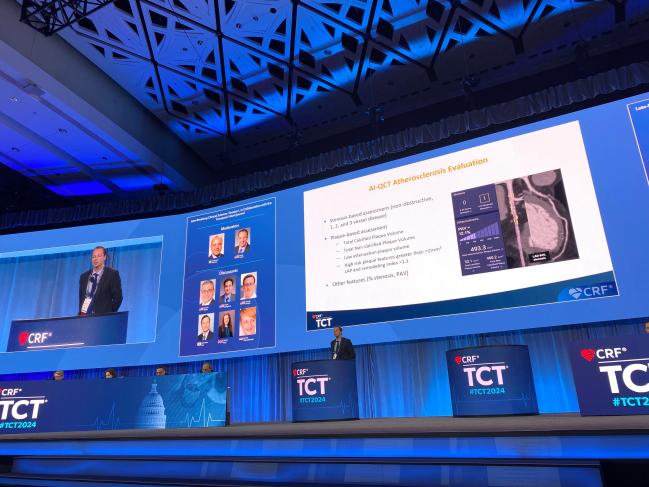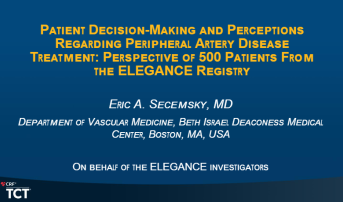CONFIRM2 Shows Power of AI-QCT to Use Plaque Features to Predict CAD Events
With further refinement and defined thresholds for treatment, this technology has the potential to guide treatment decisions.

WASHINGTON, DC—Artificial intelligence (AI) can quantify many components of CAD as imaged on quantitative coronary CT angiography (QCT), including lumen diameter stenosis and noncalcified plaque volume, which are most predictive of future MACE, according to registry data.
“The atherosclerotic profile as assessed by AI-QCT may guide tailoring of anti-atherosclerotic therapies or coronary interventional procedures to reduce cardiovascular events,” said Alexander van Rosendael, MD, PhD (Leiden University Medical Center, the Netherlands), who presented the CONFIRM2 study here at TCT 2024.
The findings are preliminary, he told TCTMD, but help physicians begin to understand the potential for technology to help fine-tune what information they can take from images to help understand plaque morphology and ultimately guide patient prognosis and treatment decisions.
What AI adds to the equation is the ability to calculate plaque metrics in minutes versus hours. “Quantitative CT has been out there already for many years,” he said. “It was always too cumbersome to do.”
“This is the very beginning,” van Rosendael added. “These quantitative values are very new, and almost no physician is familiar with them. So that's what hopefully CONFIRM2 can learn. This is a very high-risk patient because the noncalcified plaque is ‘this’ and the high-risk plaque features are ‘that’. And ‘this’ is actually only a little bit of noncalcified plaque and maybe ‘that’ is associated with very few events and we don't need to do that much.”
Technologies like these are poised to disrupt how procedures are done today, predicted Jeffrey Moses, MD (Columbia University Irving Medical Center, New York, NY). “We're getting to the point where we're actually planning the PCI from the CT and bringing it into the cath lab,” he commented during a press conference.
CONFIRM2 Findings
For the study, van Rosendael and colleagues looked at 3,551 patients (mean age 58.5 years; 50.5% male) with suspected CAD referred for coronary CTA at 18 sites in 13 countries. The most common cardiac symptom was atypical angina (37.6%), followed by dyspnea (21.2%) and typical angina (19.1%).
Conventional CTA found nonobstructive plaque in 60.4% of patients; obstructive CAD was identified in one vessel in 9.9% of patients, two vessels in 3.2%, and three vessels or the left main in 1.4% of patients. The AI-QCT found a mean total plaque volume of 152.12 mm3, noncalcified plaque volume of 91.47 mm3, and calcified plaque volume of 59.67 mm3.
Over a mean follow-up period of 4.8 years, the rate of the primary composite endpoint of all-cause mortality, MI, stroke, congestive heart failure, late revascularizations (> 90 days), or hospitalizations for unstable angina was 5%. There were 24 measures on the AI-QCT related to plaque volume, CAD extent, and others including high-risk plaques, percent atheroma volume, and diameter stenosis that were found to be the most predictive of events.
The two that proved most predictive were lumen diameter stenosis (multivariable HR 1.251 per 10%; 95% CI 1.183-1.323) and noncalcified plaque volume (multivariable HR 1.069 per 50 mm3; 95% CI 1.033-1.107). These two variables were associated with a combined area under the curve of 0.755.
In multiple analyses, the AI-QCT gave added predictive value over traditional risk models, even when clinical risk factors were added.
‘More Efficient and More Predictable’
At a press conference, Juan Granada, MD (Cardiovascular Research Foundation, New York, NY), spoke to the future potential of AI to improve the field of cardiology. “It's going to make things more efficient and more predictable, but what is amazing to me is the way that AI does things in which it is not only looking at the patient, per se, but at the entire universe of variables, including risk factors, and putting everything together in a way that can allow us to make better decisions in the future,” he said. “This is a study that I'm very excited about and in the future, we're going to see more and more and more of this.”
Van Rosendael said the next step is to better define thresholds of plaque characteristics to be able to better allocate therapies based on them.
The granularity with which AI can analyze plaques is “remarkable,” Granada added. “The imaging software [is] collecting information on the appearance of the perivascular fat, the magnitude of fat, the position, the location, and it's getting all this information, and as they learn more from the patient in terms of events, they're going to be able to predict events in ways that our human eye will not be able to do.”
Tools to assess ischemia based on the CT features are also in development, said van Rosendael. “That's probably going to help with selecting the vessels for intervention with PCI.”
He predicts that future research from the CONFIRM2 registry will help refine our understanding of what the different plaque features and values mean. But at this point, he stressed that “noncalcified plaque matters. The more, the worse, absolutely.” Also, even if the patient has only a few symptoms but a lot of atherosclerosis, “you need to know this is a very high-risk patient and you need to do anything to avoid him from getting a heart attack. Take your findings on your CT. Take them to guide your therapies.”
Yael L. Maxwell is Senior Medical Journalist for TCTMD and Section Editor of TCTMD's Fellows Forum. She served as the inaugural…
Read Full BioSources
Van Rosendael A. AI-guided quantitative coronary CT angiography (AI-QCT) technology in patients with suspected coronary artery disease: findings from a global multi-center registry. Presented at: TCT 2024. October 28, 2024. Washington, DC.
Disclosures
- Van Rosendael reports receiving grant/research support from Cleerly.






Comments